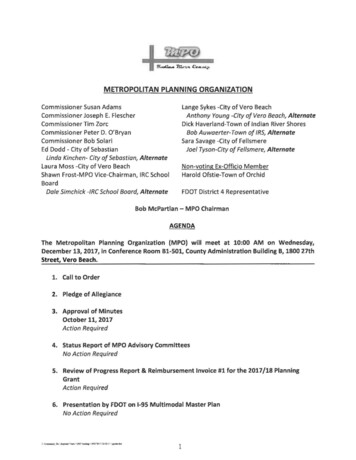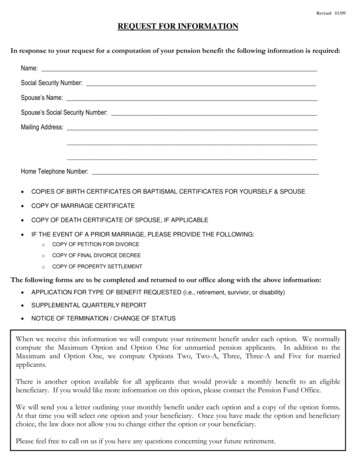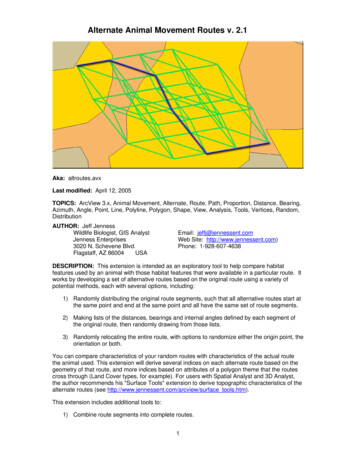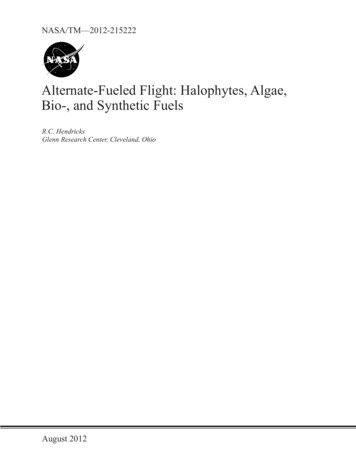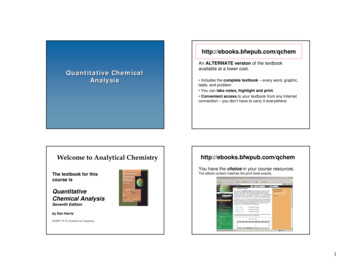
Transcription
http://ebooks.bfwpub.com/qchemQuantitative ChemicalAnalysisWelcome to Analytical ChemistryAn ALTERNATE version of the textbookavailable at a lower cost. Includes the complete textbook – every word, graphic,table, and problem You can take notes, highlight and print. Convenient access to your textbook from any Internetconnection – you don’t have to carry it everywhere.http://ebooks.bfwpub.com/qchemYou have the choice in your course resources.The textbook for thiscourse isThe eBook content matches the print book exactly.QuantitativeChemical AnalysisSeventh Editionby Dan Harris( 2007, W.H. Freeman & Company)1
http://ebooks.bfwpub.com/qchemIf your textbook waspackaged with an eBookaccess code, you canredeem it at the site:Need support?1. Click “register.”2. Fill out the informationand you’re ready to go.1-800-936-6899 Monday-Friday, 9-5 EST* Be sure to hold on to the accesscard until you redeem qchemIf you would like topurchase the access,you can do so at the site:1. Click “purchase.”2. Enter your school Zipcode3. Choose a user nameand password. Fill outthe remaining info andyou’re ready to go.* Be sure to remember yourusername and password2
Required math skills: ACCURATEPRECISEACCURATENOT preciseNOT AccuratePRECISERandom errorsystematic errorAddSubtractMultiplyDividePowersLogarithms3
Orders of magnitudeEstimationUnitsConversionsPowers of 10PrefixesErrorsStatisticsEstimation and orders of magnitude:What is thenational debt?Estimation and orders of magnitude:Estimation and orders of magnitude:How many pianotuners are there inChicago?What is the worldpopulation?4
How many watermolecules in 1000droplets?Estimation and orders of magnitude: powers of 10Estimation and orders of magnitude:Estimation and orders of magnitude:A cube – 1” on a side Æ (2.6)3 cm3 18 cc18 cc 18 cc (1 g/1 cc) 18 g18 g 18 g (1 molecule/ (18 x 1.66x10-24 g)) 6.022 x 1023 molecules5
Chemical concentrationsMolarity Moles of solute/Liters of Solution (M)Molality Moles of solute/Kg of Solvent (m)Mole Fraction Moles solute/total number of molesMass % Mass solute/total mass x 100Volume % volume solute/total volume x 100ppm parts per million *ppb parts per billion ** mass for solutions, volume for gasses6
Chemical concentrationsMolarity Moles of solute/Liters of Solution (M)Molality Moles of solute/Kg of Solvent (m)Mole Fraction Moles solute/total number of molesMass % Mass solute/total mass x 100Volume % volume solute/total volume x 100ppm parts per million *ppb parts per billion *A sample of NaNO3 weighing 8.5 grams is placed in a 500 mlvolumetric flask and distilled water was added to the mark on theneck of the flask. Calculate the Molarity of the resulting solution.Convert the given grams of solute to moles of solute by dividing bythe molecular weight of NaNO3: 1 mole NaNO3 Molecularmass of NaNO3 expressed in grams 23 14 3(16) 85grams(8.5 grams NaNO3) X (1 mole NaNO3 / 85 grams NaNO3) 0.1 mole NaNO3Convert given ml of solution to liters by dividing by 1000:1 liter 1000 ml(500 ml) X (1 liter / 1000 ml) 0.500 litersApply the definition for Molarity: Molarity moles NaNO3 / volumeof the solution in litersM 0.1 mole / .500 liters 0.200 Molar NaNO3* mass for solutions, volume for gassesChemical concentrationsChemical concentrationsMolarity Moles of solute/Liters of Solution (M)Molarity Moles of solute/Liters of Solution (M)Molality Moles of solute/Kg of Solvent (m)Molality Moles of solute/Kg of Solvent (m)Mole Fraction Moles solute/total number of molesMole Fraction Moles solute/total number of molesMass % Mass solute/total mass x 100Mass % Mass solute/total mass x 100Volume % volume solute/total volume x 100Volume % volume solute/total volume x 100ppm parts per million *ppb parts per billion *ppm parts per million *ppb parts per billion ** mass for solutions, volume for gasses* mass for solutions, volume for gasses7
Determine the molality of 3000 grams of solution containing37.3 grams of Potassium Chloride KCl.1. Convert grams KCl to moles KCl using the molecularweight of KCl(37.3 grams KCl) X (1 mole KCl / 74.6 grams KCl) 0.5 mole KCl2. Determine the grams of pure solvent from the given gramsof solution and soluteTotal grams 3000 grams Mass of solute Mass of solventMass of pure solvent (3000 - 37.3) gram 2962.7 gram3. Convert grams of solvent to kilograms(2962.7 grams solvent) X (1 kg / 1000 grams) 2.9627 kgChemical concentrationsMolarity Moles of solute/Liters of Solution (M)Molality Moles of solute/Kg of Solvent (m)Mole Fraction Moles solute/total number of molesMass % Mass solute/total mass x 100Volume % volume solute/total volume x 100ppm parts per million *ppb parts per billion ** mass for solutions, volume for gassesDetermine the molality of 3000 grams of solution containing37.3 grams of Potassium Chloride KCl.Determine the mole fraction of KCl in 3000 grams ofaqueous solution containing 37.3 grams of PotassiumChloride KCl.4. Apply the definition for molalitymolality moles of KCl / kilograms of solvent 0.5 / 2.9627 0.169 m1. Convert grams KCl to moles KCl using the molecularweight of KCl(37.3 grams KCl) X (1 mole KCl) / (74.6 grams KCl) 0.5 mole KCl2. Determine the grams of pure solvent water from thegiven grams of solution and soluteTotal grams 3000 grams Mass of solute Mass of waterMass of pure solvent (3000 - 37.3) gram 2962.7 gram8
Determine the mole fraction of KCl in 3000 grams ofaqueous solution containing 37.3 grams of PotassiumChloride KCl.Determine the mass % of a NaCl solution if 58.5 grams of NaClwas dissolved in 50 ml of water (assume the density of water tobe 1 g/ml)3. Convert grams of solvent H2O to mols(2962.7 grams water) X (1 mol / 18.0 grams) 164.6 mols H2OConvert ml of water to gramsmass (50 ml) X (1 g/ml) 50 grams water4. Apply the definition for mole fraction mole fraction moles of KCl / Total mols of KCl and water 0.5 / (0.5 164.6) 0.5 / 165.1 0.00303Determine total mass of solutionMass of solution mass of solute mass of solvent 58.5 50 108.5 gApply the definition of mass percent mass % 58.5 (100) / 108.5 53.9% NaClChemical concentrationsChemical concentrationsMolarity Moles of solute/Liters of Solution (M)Molarity Moles of solute/Liters of Solution (M)Molality Moles of solute/Kg of Solvent (m)Molality Moles of solute/Kg of Solvent (m)Mole Fraction Moles solute/total number of molesMole Fraction Moles solute/total number of molesMass % Mass solute/total mass x 100Mass % Mass solute/total mass x 100Volume % volume solute/total volume x 100Volume % volume solute/total volume x 100ppm parts per million *ppb parts per billion *ppm parts per million *ppb parts per billion ** mass for solutions, volume for gasses* mass for solutions, volume for gasses9
Assuming the density of water to be 1 g/mL we approximate thedensity of a dilute aqueous solution to be 1 g/mLÆ 1 ppm 1 μg/mL 1 mg/LÆ 1 ppb 1 ng/mL 1 μg/LDetermine the ppm of a NaCl solution if 58.5 grams of NaCl wasdissolved in 50 ml of water (assume the density of water to be 1g/ml)Convert ml of water to gramsmass (50 ml) X (1 g/ml) 50 grams waterDetermine total mass of solutionMass of solution mass of solute mass of solvent 58.5 50 108.5 gApply the definition of ppm58.5 (106) / 108.5 5.39 x 105 ppm NaCl10
11
Total grams 3000 grams Mass of solute Mass of solvent Mass of pure solvent (3000 - 37.3) gram 2962.7 gram 3. Convert grams of solvent to kilograms (2962.7 grams solvent) X (1 kg / 1000 grams) 2.9627 kg Determine the molality of 3000 grams of solution containing 37.3 grams of Potassium Chloride KCl. 4. Apply the definition for molality







